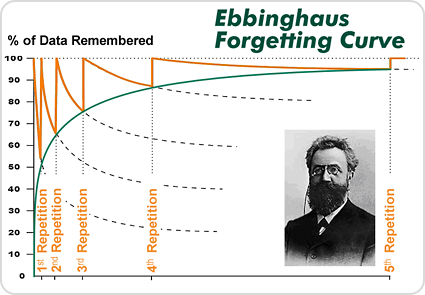Task 21: The Ebbinghaus forgetting curve
Ebbinghaus was born on January 24, 1858.
See the complete article here:
http://helpingpsychology.hubpages.com/hub/Ebbinghaus-Forgetting-Curve-The-Theory-of-Memory
He received his education at the universities of Bonn, Berlin and Halle and received his doctorate in 1873. He initially studied higher cognitive functions using a scientific process, rather than basing it on philosophy as was common at the time. Following in that vein, Ebbinghaus focused his studies on memory and forgetting. He wanted to develop a means of visualizing learning, which involves memorizing and forgetting, and discover how it works within the human mind. His first hurdle was to find a means to study “pure” learning. In his experiments, he decided to use himself as the subject. His next problem was to find material to learn that had absolutely no meaning or relationship to anything he already knew. Ebbinghaus finally decided to use three-letter "nonsense words" which consisted of a consonant-vowel-consonant formation. For his study, he created 2,300 of these nonsense words. His study began with him learning multiple lists of the created nonsense words. His pre-established standard was to be able to have perfect recall of the words, and he studied each list until he had them memorized. He then recorded his recall of these “words” at different time intervals ranging from 20 minutes to 31 days, all in the time span of one year. The results of Ebbinghaus’s experiments revealed a relationship between the forgetting of learned information over time. He found that a good part of what a person forgets takes place within 20 minutes of the initial learning. Within one hour, a person forgets nearly half of what was originally learned. After 24 hours, almost 2/3 of the previously learned material is forgotten. These results are known as the " Ebbinghaus Forgetting Curve..."

Now answer the following questions:
Who is the forgetting curve named after?
Within one hour, a person forgets nearly half of what was originally learned? (true or false).
See the complete article here:
http://helpingpsychology.hubpages.com/hub/Ebbinghaus-Forgetting-Curve-The-Theory-of-Memory
He received his education at the universities of Bonn, Berlin and Halle and received his doctorate in 1873. He initially studied higher cognitive functions using a scientific process, rather than basing it on philosophy as was common at the time. Following in that vein, Ebbinghaus focused his studies on memory and forgetting. He wanted to develop a means of visualizing learning, which involves memorizing and forgetting, and discover how it works within the human mind. His first hurdle was to find a means to study “pure” learning. In his experiments, he decided to use himself as the subject. His next problem was to find material to learn that had absolutely no meaning or relationship to anything he already knew. Ebbinghaus finally decided to use three-letter "nonsense words" which consisted of a consonant-vowel-consonant formation. For his study, he created 2,300 of these nonsense words. His study began with him learning multiple lists of the created nonsense words. His pre-established standard was to be able to have perfect recall of the words, and he studied each list until he had them memorized. He then recorded his recall of these “words” at different time intervals ranging from 20 minutes to 31 days, all in the time span of one year. The results of Ebbinghaus’s experiments revealed a relationship between the forgetting of learned information over time. He found that a good part of what a person forgets takes place within 20 minutes of the initial learning. Within one hour, a person forgets nearly half of what was originally learned. After 24 hours, almost 2/3 of the previously learned material is forgotten. These results are known as the " Ebbinghaus Forgetting Curve..."

Now answer the following questions:
Who is the forgetting curve named after?
Within one hour, a person forgets nearly half of what was originally learned? (true or false).

